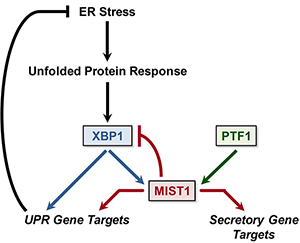MIST1, PTF1, and XBP1 Link Secretion and Stress as both Transcriptional Targets and Regulators
12-20-2016
 Secretory cells utilize complex transcriptional mechanisms for ascertaining, augmenting, and adapting to the extreme demands placed on their protein synthesis machinery. The Konieczny lab (David Hess, Anju Karki, Katie Strelau, Daniel DiRenzo) and colleagues at UT Southwestern partnered to assess how the master transcription factors MIST1, PTF1 and XBP1 are involved in co-regulating different aspects of protein production, modification and secretion. In two related studies published in the December issue of Molecular and Cellular Biology [Hess et al. (2016) MCB 36:2931-2944 (http://mcb.asm.org/content/36/23/2931); Jiang et al. (2016) MCB 36:2945-2955 (http://mcb.asm.org/content/36/23/2945)] the team utilized RNA-Seq, ChIP-Seq, transgenic mouse and disease models to reveal how MIST1, PTF1 and XBP1 collaborate in feed-forward regulatory loops that maintain the secretory cell phenotype. These findings provide new insights into how the MIST1/PTF1/XBP1 axis controls the dysregulated secretory and stress response pathways commonly altered in human diseases and opens up new avenues to improving patient therapeutic responses.
Secretory cells utilize complex transcriptional mechanisms for ascertaining, augmenting, and adapting to the extreme demands placed on their protein synthesis machinery. The Konieczny lab (David Hess, Anju Karki, Katie Strelau, Daniel DiRenzo) and colleagues at UT Southwestern partnered to assess how the master transcription factors MIST1, PTF1 and XBP1 are involved in co-regulating different aspects of protein production, modification and secretion. In two related studies published in the December issue of Molecular and Cellular Biology [Hess et al. (2016) MCB 36:2931-2944 (http://mcb.asm.org/content/36/23/2931); Jiang et al. (2016) MCB 36:2945-2955 (http://mcb.asm.org/content/36/23/2945)] the team utilized RNA-Seq, ChIP-Seq, transgenic mouse and disease models to reveal how MIST1, PTF1 and XBP1 collaborate in feed-forward regulatory loops that maintain the secretory cell phenotype. These findings provide new insights into how the MIST1/PTF1/XBP1 axis controls the dysregulated secretory and stress response pathways commonly altered in human diseases and opens up new avenues to improving patient therapeutic responses.